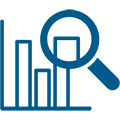
Connect with our experts and industry leaders to uncover strategies to help you achieve more.
Could manual processes and a lack of visibility be holding your supply chain back?
By
Date
June 02, 2021

By Cindy Jeter, CPhT, CPP, BGS
Read time: 4 minutes
Whether your organization is expanding its geographic footprint, adding services, or simply taking a fresh look at your systems and workflow efficiency, it has never been more critical to optimize your supply chain. And frequently, consolidating or streamlining your IT infrastructure is the first step. Here are four ways a solid IT infrastructure could help strengthen your supply chain.
 Automating your processes
Automating your processesAs organizations evolve to serve patients in multiple care settings, the complexity, cost and effort associated with the supply chain infrastructure increases exponentially. Combining data from siloed departments or different facilities is one of the first, most essential steps in creating a well-informed supply chain strategy to streamline purchasing power, manage drug shortages and optimize inventory management.
In addition to technology considerations, another important variable may come into play—a lack of automated supply chain systems. According to an industry survey, more than half of survey respondents said their hospital uses manual or spreadsheet processes to track supply chain information in the operating room. Additionally, just under one-third said they haven't deployed analytics software to assess their supply chains for areas to improve quality and efficiency. This reliance on manual processes can lead to inefficiencies, duplicated labor and uneconomical and wasteful results.
The good news for those who lack automated supply chain processes is there is an optimization initiative that provides an ideal opportunity to build a beneficial infrastructure from the ground up. With the right automated system, hospitals should be well positioned to benefit from accurate tracking of drug utilization, pharmacy initiatives, contract optimization and electronic records on purchasing history and wastage.
With a well-orchestrated supply chain platform in place, hospitals can begin to transform volumes of data into reliable, relevant analytics.
 Moving raw data to actionable analytics
Moving raw data to actionable analyticsHaving the right analytics can prevent product stock-outs or overstocks, pinpoint critical details to ensure compliance and increase reimbursements, and make the entire supply chain work in sync to support both quality care and operational efficiency. Having a shared IT platform helps to make this possible.
Before developing an analytics strategy, it’s essential to gain insights from a multidisciplinary team of clinicians, IT professionals and support staff to define shared goals. Organizations can empower the combined team to see beyond their own data sets, focusing instead on how familiar data from their immediate purview fits into the big picture. This is important because supply chains are made up of layers upon layers of interdependent components, including ancillary supplies, pharmaceutical suppliers, pricing tiers, reimbursement models and much more.
With these stakeholder insights in mind, and with a shared IT platform to support these advanced analytics, hospitals are empowered to:
 Having challenging conversations
Having challenging conversationsIn some ways, even complex conversations about technology platforms and supply chain analytics can pale in comparison to the topics of everyday processes and cultural norms in growing organizations. And in many cases, the healthcare and IT professionals going through a supply chain optimization initiative simply don’t know what they don’t know.
A consulting partnership with an independent third party often proves to be useful. By optimizing your supply chain through process and technology consulting, you can expect to reduce spend while enhancing efficiency and exploring untapped sources of revenue to improve both your health system’s performance and patient outcomes.
 Leveraging outside consulting
Leveraging outside consultingOptimizing the supply chain is a task that deserves and demands the attention of healthcare decision makers. Yet, in many cases, executives and staff tend to underestimate the amount of time, planning and hands-on project management that go into these strategies. And while it can be tempting for organizations to assign additional duties to willing individuals in the name of saving money, it’s important to consider the time and cost of using trained clinicians to perform unfamiliar tasks that, by nature, can’t be their first priority.
By partnering with an experienced supply chain consultant from the start, organizations can quickly identify and resolve gaps, disconnects and other obstacles that can stand in the way of profitability. Just as significantly, optimizing and standardizing the combined supply chain helps them function seamlessly as one organization, keeping patients at the center of the newly defined continuum of care.
Learn more about how we can help you achieve more for your supply chain infrastructure. Contact us.
Cindy Jeter, CPhT, CPP, BGS, is a supply chain management consultant for McKesson Macro Helix. As a Certified Purchasing Professional, Cindy is one of McKesson’s top experts for supply chain consulting. Her focus includes best-practice inventory management processes, wastage reduction and cost containment.